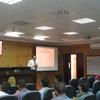Research on the Influence of the Light and Compound Feed on Growth Performance into Young Quail Mixed Eggs-meat Population of Balotesti During 28-56 Days
In order to study the influence of the light and compound feed on growth performance into young quail mixed-population of Balotesti was organized an experiment on 400 chicken quails. It has studied the impact of an illumination program with asymmetrical hourly intervals (10L+2N+6L+6N) compared with a program of continuous lighting in day period (16L+8N). It was used 3 types of compound feed: for growth, finishing and for adult quails. The growth performance of young quails during the period 28-49 days were superior in the case of lots of female animals (B1) and male (B2) compared with the consignments of female (A1) and male (A2).
The average live weight at the age of 49 days was higher with 9.67% at the females from the lot B1 compared with females from lot A1, while to male this was higher with 6.95% at the males of the lot B2 compared with males from the lot A2. In the period 49-56 days the weight gain at males from the lot A2-2 has been with 6.30 g/head higher than to male from the lot of A2-1, and feed consumption rate has been reduced by 19.10 g c.f./g weight gain to the consignment A2-2 from the consignment A2-1. Increase of growth to male from the lot B2-2 has been with 6.88 g/head higher than to male from the lot B2-1 and feed consumption rate has been reduced by 17.60 g c.f./g weight gain to lot B2-2 compared the lot B2-1.
Considering the superior performance recorded in the case of lots A2, B2, A2-2 and B2-2 during the periods concerned, it is recommended to use the illumination program with the hourly intervals asymmetrical with a duration of 16 hours in growth young quail still from the age of 28 days, the management of the finishing compound feed to male for meat in the period 49-56 days and the feed for adult quail females from the age of 49 days.
This abstract was originally published in Agriculture and Agricultural Science Procedia, Volume 10, 2016, Pages 261–269. http://dx.doi.org/10.1016/j.aaspro.2016.09.063.















